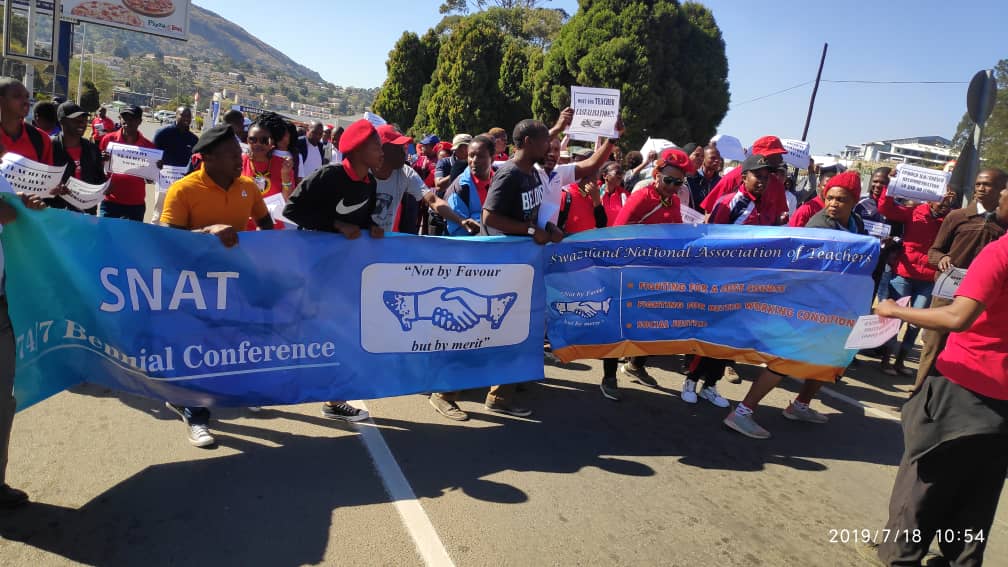Brief History of the SNAT
The Swaziland National Association of Teachers (SNAT) was formed in 1928. It is the only recognized educators’ Association in the country. Its founding president was Prince Lomngeletjane, who was the headmaster at Zombodze Primary School. Christopher Aphane, a teacher at Mbekelweni Primary School then, its Secretary General. Its members are cross cutting; pre- school teachers, primary and high school teachers, head teachers, Education inspectors, Regional Education officers and college lecturers.The SNAT has three (3) types of membership. These Active members include registered and certified teachers, Associate members who consist of pre-school teachers, retired teachers, student teachers and teachers on secondment. The last category is that of Honorary members who are members recognised for their special contribution to the SNAT or in the education field. The members of the organization are found throughout the country in all the corners of the kingdom. In each school in the urban, semi-urban, and remote areas of the land where there is a school, a teacher or member is found.
Between 1928 and the late 1960s, schools in Swaziland were divided into three categories. There were Europeans, Coloured and African schools. European schools, followed by coloured schools received preferential treatment from the colonial Government. They had all sorts of social amenities, superior educational equipment and highly qualified teachers who received attractively high salaries. On the contrary, African schools were neglected. African schools themselves in Swaziland were also divided into four categories of schools. There were Government schools, popularly known as Central schools such as Mbabane Central, Lomahasha Central, Lubombo Central, Nhlangano Central and many others. There were also National schools such as Matsapha, Zombodze and Lobamba. The other two categories were Community and Mission schools. Teachers in National schools were initially the highest paid group. But the Government soon placed her teachers above those who were teaching in National schools in the pay roll. This made teachers who were teaching in National schools the second highest paid group. Teachers in Government schools were employed and paid by the Government.Those in national schools were employed and paid by the Swaziland National Council. These two groups of schools received their salaries monthly. Teachers in mission schools were employed and paid by the Churches. They received their meagre salaries quarterly, every three months. Those who were in community schools received almost nothing since chiefs and communities had no means of generating money for paying their salaries.
The first remarkable Industrial Action by teachers in Swaziland was in 1966 whereby teachers staged a demonstration for unified higher salaries and improved conditions of service. The then Swaziland National Union of Teachers (SNUT) forced government to improve conditions of service and salaries for teachers by advocating for the establishment of a Unified Teaching Service (UTS). This body was to be responsible for the employment and payment of all teachers in the country irrespective of the schools in which they were teaching. They wanted an autonomous and independent Teaching Service Commission (TSC), which was finally established in 1982. The second Industrial action by the SNUT was in 1977 over the wamalwa salary review report. The Government of Swaziland banned the SNUT and it was resuscitated in 1983 after the then Minister Dabulumjiva Nhlabatsi lifted the ban on condition that the then leadership changed the name of the organization from The Swaziland National Union of Teachers (SNUT) into being The Swaziland National Association of Teachers (SNAT), a name that the organization has maintained until today.
In advancing the economic interests of its members, the SNAT formed the SNAT Cooperative Society which was launched on June 28, 1986 at the Trade fair Grounds with the interim Management comprising of Albert Heshane Shabangu as Chairperson, A. Putsoa as Secretary, F. Mabundza as Treasurer and D. Hlatjwayo and Z. Mlambo as Committee Members. In 2003, the SNAT formed the SNAT Burial to ensure members are buried with dignity. In 2018, the SNAT burial formed the SNAT Medical Aid Scheme to ensure members receive the highest level of health care at an affordable rate. In 2019, the Burial scheme established SNAT Burial Services - a company that offers funeral products for the general public at affordable rates. .
